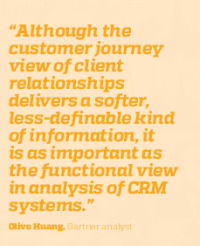Published on the 19/06/2014 | Written by Anthony Doesburg

Successful businesses today must continually take the pulse of their varied customer base and respond to their wants and needs. And what better way to do this than with the plethora of cloud-based, affordable and accessible tools on the market for just that purpose? But which to choose? And why?…
If the customer is king, social media provides high and mighty consumers with powerful new ways to make life miserable for the merchant class. Using Facebook, Twitter, Pinterest and other platforms, shoppers swap notes from consumerism’s frontlines that can make or break business reputations. To prosper in this cut-throat version of the royal court, merchants are having to acquire tools to gauge their status with the king before a cry of ‘off with their heads’ jolts them from complacency. The result is a boom in customer relationship management software sales and an explosion in the number of products, and vendors, vying for a share of the action.
The straightforward – or functional view – of CRM spans an organisation’s customer-related activities including sales, marketing, customer service, master data management and analytics. But there’s another way of looking at CRM, taking a customer experience or customer journey view, that is spawning a confusing mass of tools designed to take advantage of merchant paranoia. These tools’ purpose is to measure customer perception of the organisation before, during and after engagement.
“CRM, as Gartner talks about it, has quite a large scope,” says Gartner’s Sydney analyst Olive Huang with more than a trace of understatement. The CRM software category is so vast that it fills not one but 18 of the firm’s ‘magic quadrants’, its signature method for assessing products’ strengths which divides vendors into leaders, challengers, niche players and visionaries. They range from CRM systems for multichannel campaign management and contact centre infrastructure to sales force automation.
And the sector’s scope is expanding: it is expected to grow at a compound annual rate of almost 15 percent through to 2017, with cloud CRM deployments increasing by nearly a quarter.
IBM, SAP and Oracle each crop up in more than half of the CRM categories Gartner analyses, and Salesforce.com and Microsoft Dynamics CRM are also prominent. But customers should not expect to get their desired functionality from a single vendor. “It is normal for large organisations to have up to seven different products,” Huang says, and they need to interface with each other.
Sense and respond
One way of describing what these products facilitate is a ‘sense and respond’ approach to doing business, which contrasts with the old-school ‘make and sell’ model. Australian pizza chain Eagle Boys is doing it the new way: it has seen the virtue of gaining insight into customer appetites as opposed to trying to feed them what it thinks they might want.
The Queensland-based company’s story also illustrates the diversity of software that today sits on the CRM shelf. Eagle Boys uses cloud-based Google Maps for Business to record delivery addresses for online orders.
Analysis of the mapping software’s geospatial data enables franchisees to see how the popularity of different pizza flavours varies over time and to relate spikes in sales to events such as sports matches, arming it with information to plan for future events.
Sneaky or smart?
Another form of intelligence-gathering is social selling, which Warren Everitt of MarketOne Australia says relies on using channels such as LinkedIn for lines into potential customer organisations.
“We use it heavily not only for our business development purposes but for our customers’, too,” says Everitt, Australian managing director of the US-based marketing consultancy.
It might be as obvious as finding connections between MarketOne’s overseas offices and the target organisation, then using that information to get past the ‘gatekeeper’ who answers the target’s phones.
“We can go in with the pitch that they’re an existing customer. It’s almost sneaky because they’re not an existing customer in the region we’re calling from.”
Sneakiness is the name of the game:
competitors can use the same methods to see who your customers are so they can try to steal them. Everitt concedes that social network noise can be a distraction but says there’s no ducking the fact that the selling methods of the bricks and mortar marketplace are losing relevance.
Truth prevails
“We’re moving to a world where most products and services are being sold online.”
A savvy social media plan is therefore necessary not just for finding opportunities but also for putting out fires.
“We have tools for what’s called social listening, which can scan the web for a customer’s name. Complex algorithms then match the name with any negative or derogatory terms. We can then get reports of the locations of those negative posts so we can attempt to understand their origins.
“Is it someone with a product issue or did they try to get customer support but weren’t happy with the outcome? Or is a competitor trying to defame you and if so, what’s its impact and how do you stop it going viral?”
As in the physical world, Everitt says some people believe any online publicity is good publicity. Gartner’s Huang lends that view some weight with her conviction that sabotage by competitors doesn’t get far in the social media realm because the truth has a way of asserting itself.
Huang says although the customer journey view of client relationships delivers a softer, less definable kind of information, it is as important as the functional view in analysis of CRM systems. The trouble is the sheer volume of products – thousands, according to Everitt – that are trying to squeeze into the customer experience management space.
Indeed, Huang says, “everyone will tell you they’re selling these kinds of products. They range from contact centre telephony solutions and multichannel campaign management to voice recognition analytics.” And much more besides.
Providers want to capitalise on the trend for organisations to use every possible medium to take the customer’s pulse throughout ‘the journey of engagement’ and especially at ‘the moment of truth’ when a sale is closed.
Strategy first
If you are buying a CRM system to differentiate itself from competitors, it makes sense for an organisation to choose one with customisation in mind. But if the system’s role is not competitive, an out-of-the-box solution will probably do. Gartner’s advice is to put business strategy and requirements ahead of vendor selection when shopping for a system. Nor should customers get hung up on choosing a supplier from the ‘leader’ quadrant, since the most suitable and affordable solution might be found with a challenger, visionary or niche provider.
An organisation wanting to get the best reading it can on customer sentiment should study the CRM magic quadrant covering customer engagement centres. Magic quadrants dealing with sales and marketing will guide them to systems for appropriate follow-up actions.
“Organisations need to be able to listen in and understand what customers think about them,” Huang says.
And sensing where they stand, they need to respond. But there’s a line to be walked in avoiding being too intrusive.
“That’s where sensing the pulse is important because you don’t want to annoy your customer. And that’s where there’s a link to using big data analytics to segment your customers.”
Slice and dice
Segmentation’s aim is to understand the frequency and type of communication a customer prefers – not that the outcome is always accurate. A two metre-tall 120kg male colleague of Huang was clearly not the intended target of a misdirected summer marketing campaign.
“It was an advertisement for colourful high-heeled shoes. I asked him if there was something that he thought he should be telling us, and of course, he said it was an excellent example of wrong segmentation.”
The blunder illustrates another fine line between a clever outcome of technology-driven marketing and a damaging one. It also hints at the different origins of such systems.
“One group is traditional email campaign management vendors, which are very smart at personalising messages based on a person’s profile. The second group is new channel vendors that base the ads or promotions they send you on what you browse online and what you do on Facebook, Twitter and Snapchat.”
Gartner estimates only about 15 percent of companies have social media listening platforms and only a small number of those are translating the noise they hear into product support or marketing responses.
Huang says: “The messages your social analytics tool is hearing need to be brought into the marketing, campaign management and service departments, so a number of interfaces need to be built. But the technology is the easy part – what is hard is getting the marketing, sales and service departments to work as one team.”
The pace of adoption for social media listening software looks to be picking up, according to a survey of 330 Australian and New Zealand marketing managers by Sitecore, a UK-based customer experience management platform provider. This year, it says, digital marketing spending – primarily on social media – will eclipse offline spending. The choices aren’t simple, however.
Spoilt for choice
As one surveyed marketing manager said: “I feel overwhelmed at the enormity of creating and implementing a digital marketing plan with very little budget.”
Sitecore Australia and New Zealand managing director Robert Holliday, whose customers include the Australian Army and Statistics New Zealand, sympathises. “Marketers are faced with a diverse and growing range of channels, a consumer journey with multi-channel touch points, different technologies to deliver to each channel and no consistent approach to the measurement of marketing effectiveness.”
Telecommunications company Optus tackled the issue of getting all channels and departments to work together by changing its organisation structure, appointing a consumer group head with end-to-end responsibility for those three functions. Other organisations are creating the role of chief customer officer.
Cloud affinity
CRM, as comparatively lightweight software whose data mostly originates outside the firewall, is eminently suited to cloud delivery. Its coming of- age in the social media era also saves it from data centre capture. A major side benefit of cloud deployment is affordability as it allows much smaller organisations to use solutions they couldn’t have before.
CRM vendors themselves come in many guises. Google, whose Maps for Business software is used by Eagle Boys pizza, is at least recognisable as a software company. But American Express? As a response to the competition posed by internet payment systems and digital wallet providers, the credit card company has become a financial added-value service provider for retailers, making use of the records it has of cardholder transactions.
A programme that it promotes through social media links customer likings for certain products with discount vouchers that are applied at card level. When customers see a promotion for a product they like on American Express’ Facebook page, they can use Amex’s ‘link, like, love’ application to add a voucher to their credit card, which then automatically applies the discount at the checkout.
It’s extremely efficient precision marketing executed in a very smooth loop. In one swoop American Express has moved itself from being a credit card company to being a big data value added service provider, all done in the cloud.
Long live the king
One danger of the drive to probe customer sentiment ever more deeply is that, if mishandled, it could result in the sort of big data backlash that followed disclosures of seemingly unrestrained surveillance of populations by national security agencies. If that happens, it could be a case of déjà vu for some analytics system providers, which also have national security arms.
For a glimpse of what is ahead, Huang points to China. “Although it doesn’t have Facebook or Twitter, it has its own social media. And in terms of commercialisation [of social media data], it is at least five years ahead of the rest of the world.”
Has that secured or undermined the position of the customer as king? If Huang’s 72-year-old mother in Beijing is typical, it’s the former: “She buys all her groceries online, she orders and pays for taxis on her mobile and she’s not special – every other Beijing grandmother is doing it. “I don’t see anything that will stop the same happening in the rest of the world.”


































